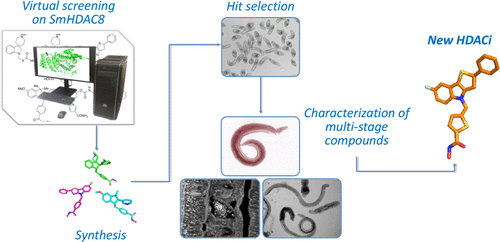当前位置:
X-MOL 学术
›
ACS Infect. Dis.
›
论文详情
Our official English website, www.x-mol.net, welcomes your feedback! (Note: you will need to create a separate account there.)
Screening and Phenotypical Characterization of Schistosoma mansoni Histone Deacetylase 8 (SmHDAC8) Inhibitors as Multistage Antischistosomal Agents.
ACS Infectious Diseases ( IF 5.3 ) Pub Date : 2019-11-12 , DOI: 10.1021/acsinfecdis.9b00224 Fulvio Saccoccia 1 , Margherita Brindisi 2 , Roberto Gimmelli 1 , Nicola Relitti 3 , Alessandra Guidi 1 , A Prasanth Saraswati 3 , Caterina Cavella 3 , Simone Brogi 3, 4 , Giulia Chemi 3 , Stefania Butini 3 , Giuliana Papoff 1 , Johanna Senger 5 , Daniel Herp 5 , Manfred Jung 5 , Giuseppe Campiani 3 , Sandra Gemma 3 , Giovina Ruberti 1
ACS Infectious Diseases ( IF 5.3 ) Pub Date : 2019-11-12 , DOI: 10.1021/acsinfecdis.9b00224 Fulvio Saccoccia 1 , Margherita Brindisi 2 , Roberto Gimmelli 1 , Nicola Relitti 3 , Alessandra Guidi 1 , A Prasanth Saraswati 3 , Caterina Cavella 3 , Simone Brogi 3, 4 , Giulia Chemi 3 , Stefania Butini 3 , Giuliana Papoff 1 , Johanna Senger 5 , Daniel Herp 5 , Manfred Jung 5 , Giuseppe Campiani 3 , Sandra Gemma 3 , Giovina Ruberti 1
Affiliation

|
Schistosomiasis (also known as bilharzia) is a neglected tropical disease caused by platyhelminths of the genus Schistosoma. The disease is endemic in tropical and subtropical areas of the world where water is infested by the intermediate parasite host, the snail. More than 800 million people live in endemic areas and more than 200 million are infected and require treatment. Praziquantel (PZQ) is the drug of choice for schistosomiasis treatment and transmission control being safe and very effective against adult worms of all the clinically relevant Schistosoma species. Unfortunately, it is ineffective on immature, juvenile worms; therefore, it does not prevent reinfection. Moreover, the risk of development and spread of drug resistance because of the widespread use of a single drug in such a large population represents a serious threat. Therefore, research aimed at identifying novel drugs to be used alone or in combination with PZQ are needed. Schistosoma mansoni histone deacetylase 8 (SmHDAC8) is a class I zinc-dependent HDAC, which is abundantly expressed in all stages of its life cycle, thus representing an interesting target for drug discovery. Through virtual screening and phenotypical characterization of selected hits, we discovered two main chemical classes of compounds characterized by the presence of a hydroxamate-based metal binding group coupled to a spiroindoline or a tricyclic thieno[3,2-b]indole core as capping groups. Some of the compounds of both classes were deeply investigated and showed to impair viability of larval, juvenile, and adult schistosomes, to impact egg production in vitro and/or to induce morphological alterations of the adult schistosome reproductive systems. Noteworthy, all of them inhibit the recombinant form of SmHDAC8 enzyme in vitro. Overall, we identified very interesting scaffolds, paving the way to the development of effective antischistosomal agents.
中文翻译:

曼氏血吸虫组蛋白去乙酰化酶8(SmHDAC8)抑制剂作为多阶段抗血吸虫病药物的筛选和表型表征。
血吸虫病(也称为bilharzia)是一种由血吸虫属的蠕虫引起的被忽视的热带病。该病是世界热带和亚热带地区的地方病,那里的中间寄生虫宿主蜗牛感染了水。超过8亿人生活在流行地区,超过2亿人被感染并需要治疗。吡喹酮(PZQ)是血吸虫病治疗和传播控制的首选药物,对所有临床相关血吸虫物种的成虫均安全且非常有效。不幸的是,它对未成熟的幼虫无效。因此,它不能防止再次感染。此外,由于在如此庞大的人口中广泛使用单一药物,导致产生和传播耐药性的风险构成了严重威胁。所以,需要开展旨在鉴定单独使用或与PZQ结合使用的新药的研究。曼氏血吸虫组蛋白脱乙酰基酶8(SmHDAC8)是I类依赖锌的HDAC,在其生命周期的所有阶段均大量表达,因此代表了有趣的药物发现靶标。通过虚拟筛选和选定命中的表型表征,我们发现了两种主要化学类别的化合物,其特征在于存在与螺螺二氢吲哚或三环噻吩并[3,2-b]吲哚核偶联的基于异羟肟酸酯的金属结合基团作为封端基团。对这两种化合物中的某些进行了深入研究,结果表明它们会损害幼虫,幼虫和成人血吸虫的活力,影响体外卵的产生和/或诱导成人血吸虫生殖系统的形态变化。值得注意的是,它们都在体外抑制SmHDAC8酶的重组形式。总体而言,我们确定了非常有趣的支架,为开发有效的抗血吸虫病药物铺平了道路。
更新日期:2019-11-13
中文翻译:

曼氏血吸虫组蛋白去乙酰化酶8(SmHDAC8)抑制剂作为多阶段抗血吸虫病药物的筛选和表型表征。
血吸虫病(也称为bilharzia)是一种由血吸虫属的蠕虫引起的被忽视的热带病。该病是世界热带和亚热带地区的地方病,那里的中间寄生虫宿主蜗牛感染了水。超过8亿人生活在流行地区,超过2亿人被感染并需要治疗。吡喹酮(PZQ)是血吸虫病治疗和传播控制的首选药物,对所有临床相关血吸虫物种的成虫均安全且非常有效。不幸的是,它对未成熟的幼虫无效。因此,它不能防止再次感染。此外,由于在如此庞大的人口中广泛使用单一药物,导致产生和传播耐药性的风险构成了严重威胁。所以,需要开展旨在鉴定单独使用或与PZQ结合使用的新药的研究。曼氏血吸虫组蛋白脱乙酰基酶8(SmHDAC8)是I类依赖锌的HDAC,在其生命周期的所有阶段均大量表达,因此代表了有趣的药物发现靶标。通过虚拟筛选和选定命中的表型表征,我们发现了两种主要化学类别的化合物,其特征在于存在与螺螺二氢吲哚或三环噻吩并[3,2-b]吲哚核偶联的基于异羟肟酸酯的金属结合基团作为封端基团。对这两种化合物中的某些进行了深入研究,结果表明它们会损害幼虫,幼虫和成人血吸虫的活力,影响体外卵的产生和/或诱导成人血吸虫生殖系统的形态变化。值得注意的是,它们都在体外抑制SmHDAC8酶的重组形式。总体而言,我们确定了非常有趣的支架,为开发有效的抗血吸虫病药物铺平了道路。



























 京公网安备 11010802027423号
京公网安备 11010802027423号